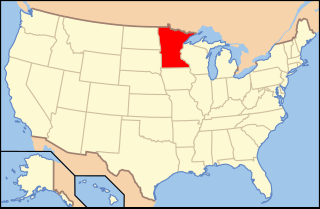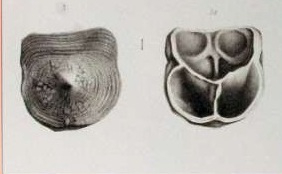
Thomas Davidson was a British palaeontologist.
An evolutionary radiation is an increase in taxonomic diversity that is caused by elevated rates of speciation, that may or may not be associated with an increase in morphological disparity. Radiations may affect one clade or many, and be rapid or gradual; where they are rapid, and driven by a single lineage's adaptation to their environment, they are termed adaptive radiations.
Ancistrocrania is an extinct genus of brachiopods from the Upper Cretaceous of Europe and North-America. The name is derived from the Greek words αγκιστρο (agkistro) "fish hook" and κρανίον (kranion) skull.

The Mesozoic marine revolution is the rapid adaption to shell-crushing (durophagous) and boring predation in benthic organisms throughout the Mesozoic era. The term was first coined by Geerat J. Vermeij, who based his work on that of Steven M. Stanley. While initially restricted to the Late Cretaceous, more recent studies have suggested that the beginning of this ecological arms race extends back into the Norian. It is an important transition between the Palaeozoic evolutionary fauna and the Cenozoic evolutionary fauna that occurred throughout the Mesozoic.

Brachiopods, phylum Brachiopoda, are a group of lophotrochozoan animals that have hard "valves" (shells) on the upper and lower surfaces, unlike the left and right arrangement in bivalve molluscs. Brachiopod valves are hinged at the rear end, while the front can be opened for feeding or closed for protection. Two major groups are recognized, articulate and inarticulate. The word "articulate" is used to describe the tooth-and-groove features of the valve-hinge which is present in the articulate group, and absent from the inarticulate group. This is the leading diagnostic feature (fossilizable), by which the two main groups can be readily distinguished. Articulate brachiopods have toothed hinges and simple opening and closing muscles, while inarticulate brachiopods have untoothed hinges and a more complex system of muscles used to keep the two valves aligned. In a typical brachiopod a stalk-like pedicle projects from an opening in one of the valves near the hinges, known as the pedicle valve, keeping the animal anchored to the seabed but clear of silt that would obstruct the opening.

Crania is an extinct genus of brachiopods that lived during the Upper Cretaceous.
Aemula is an extinct genus of brachiopods that lived during the Cretaceous period. The pedunculate brachiopod species Aemula inusitata had lived on the bodies of larger animals which served for enough feeding surface, since no large attachment sites were available on the Maastrichtian chalk of the sea floor. It was a very small animal, having a maximum length of 7 mm, and is believed to have been short lived as interpreted from its growth lines.

Paleontology or palaeontology is the study of prehistoric life forms on Earth through the examination of plant and animal fossils. This includes the study of body fossils, tracks (ichnites), burrows, cast-off parts, fossilised feces (coprolites), palynomorphs and chemical residues. Because humans have encountered fossils for millennia, paleontology has a long history both before and after becoming formalized as a science. This article records significant discoveries and events related to paleontology that occurred or were published in the year 2013.

Paleontology in Tennessee refers to paleontological research occurring within or conducted by people from the U.S. state of Tennessee. During the early part of the Paleozoic era, Tennessee was covered by a warm, shallow sea. This sea was home to brachiopods, bryozoans, cephalopods, corals, and trilobites. Tennessee is one of the best sources of Early Devonian fossils in North America. During the mid-to-late Carboniferous, the state became a swampy environment, home to a rich variety of plants including ferns and scale trees. A gap in the local rock record spans from the Permian through the Jurassic. During the Cretaceous, the western part of the state was submerged by seawater. The local waters were home to more fossil gastropods than are known from anywhere else in the world. Mosasaurs and sea turtles also inhabited these waters. On land the state was home to dinosaurs. Western Tennessee was still under the sea during the early part of the Cenozoic. Terrestrial portions of the state were swampy. Climate cooled until the Ice Age, when the state was home to Camelops, horses, mammoths, mastodons, and giant ground sloths. The local Yuchi people told myths of giant lizard monsters that may have been inspired by fossils either local or encountered elsewhere. In 1920, after local fossils became a subject of formal scientific study, a significant discovery of a variety of Pleistocene creatures was made near Nashville. The Cretaceous bivalve Pterotrigonia thoracica is the Tennessee state fossil.

Paleontology in New Jersey refers to paleontological research in the US state of New Jersey. The state is especially rich in marine deposits.

Paleontology in Minnesota refers to paleontological research occurring within or conducted by people from the U.S. state of Minnesota. The geologic record of Minnesota spans from Precambrian to recent with the exceptions of major gaps including the Silurian period, the interval from the Middle to Upper Devonian to the Cretaceous, and the Cenozoic. During the Precambrian, Minnesota was covered by an ocean where local bacteria ended up forming banded iron formations and stromatolites. During the early part of the Paleozoic era southern Minnesota was covered by a shallow tropical sea that would come to be home to creatures like brachiopods, bryozoans, massive cephalopods, corals, crinoids, graptolites, and trilobites. The sea withdrew from the state during the Silurian, but returned during the Devonian. However, the rest of the Paleozoic is missing from the local rock record. The Triassic is also missing from the local rock record and Jurassic deposits, while present, lack fossils. Another sea entered the state during the Cretaceous period, this one inhabited by creatures like ammonites and sawfish. Duckbilled dinosaurs roamed the land. The Paleogene and Neogene periods of the ensuing Cenozoic era are also missing from the local rock record, but during the Ice Age evidence points to glacial activity in the state. Woolly mammoths, mastodons, and musk oxen inhabited Minnesota at the time. Local Native Americans interpreted such remains as the bones of the water monster Unktehi. They also told myths about thunder birds that may have been based on Ice Age bird fossils. By the early 19th century, the state's fossil had already attracted the attention of formally trained scientists. Early research included the Cretaceous plant discoveries made by Leo Lesquereux.

Paleontology in Texas refers to paleontological research occurring within or conducted by people from the U.S. state of Texas. Author Marian Murray has remarked that "Texas is as big for fossils as it is for everything else." Some of the most important fossil finds in United States history have come from Texas. Fossils can be found throughout most of the state. The fossil record of Texas spans almost the entire geologic column from Precambrian to Pleistocene. Shark teeth are probably the state's most common fossil. During the early Paleozoic era Texas was covered by a sea that would later be home to creatures like brachiopods, cephalopods, graptolites, and trilobites. Little is known about the state's Devonian and early Carboniferous life. However, evidence indicates that during the late Carboniferous the state was home to marine life, land plants and early reptiles. During the Permian, the seas largely shrank away, but nevertheless coral reefs formed in the state. The rest of Texas was a coastal plain inhabited by early relatives of mammals like Dimetrodon and Edaphosaurus. During the Triassic, a great river system formed in the state that was inhabited by crocodile-like phytosaurs. Little is known about Jurassic Texas, but there are fossil aquatic invertebrates of this age like ammonites in the state. During the Early Cretaceous local large sauropods and theropods left a great abundance of footprints. Later in the Cretaceous, the state was covered by the Western Interior Seaway and home to creatures like mosasaurs, plesiosaurs, and few icthyosaurs. Early Cenozoic Texas still contained areas covered in seawater where invertebrates and sharks lived. On land the state would come to be home to creatures like glyptodonts, mammoths, mastodons, saber-toothed cats, giant ground sloths, titanotheres, uintatheres, and dire wolves. Archaeological evidence suggests that local Native Americans knew about local fossils. Formally trained scientists were already investigating the state's fossils by the late 1800s. In 1938, a major dinosaur footprint find occurred near Glen Rose. Pleurocoelus was the Texas state dinosaur from 1997 to 2009, when it was replaced by Paluxysaurus jonesi after the Texan fossils once referred to the former species were reclassified to a new genus.

Paleontology in Washington encompasses paleontological research occurring within or conducted by people from the U.S. state of Washington. Washington has a rich fossil record spanning almost the entire geologic column. Its fossil record shows an unusually great diversity of preservational types including carbonization, petrifaction, permineralization, molds, and cast. Early Paleozoic Washington would come to be home to creatures like archaeocyathids, brachiopods, bryozoans, cephalopods, corals, and trilobites. While some Mesozoic fossils are known, few dinosaur remains have been found in the state. Only about two thirds of the state's land mass had come together by the time the Mesozoic ended. In the Cenozoic the state's sea began to withdraw towards the west, while local terrestrial environments were home to a rich variety of trees and insects. Vertebrates would come to include the horse Hipparion, bison, camels, caribou, oreodonts. Later, during the Ice Age, the northern third of the state was covered in glaciers while creatures like bison, caribou, woolly mammoths, mastodons, and rhinoceros roamed elsewhere in the state. The Pleistocene Columbian Mammoth, Mammuthus columbi is the Washington state fossil.

Pygope is an extinct genus of brachiopods belonging to the family Pygopidae. These brachiopods lived in open sea from the Jurassic Period, Kimmeridgian age up to Cretaceous Period, Barremian age. Some of the species are characterised by a smaller or larger perforation through the entire shell in older specimens, while others just have a depression somewhere on the midline. Younger specimens of the perforated species develop a heart-shape and subsequently both extensions merge, thus encircling a central passage which is in fact entirely outside the shell.

Argyrotheca is a genus of very small to minute lampshells. All species share a large pedicel opening, one ridge on the inside of the pedunculate valve, pits in a diamond pattern on the inside of both valves, and without radial ridges that end in tubercles. It occurs in depths between 6 and 1300 m. It is known since the latest Cretaceous.

Peregrinella is an extinct Early Cretaceous Rhynchonellide genus with scattered, global representation from North America to Europe and Tibet. These brachiopods are stationary epifaunal suspension feeders, its most distinguishing feature is the size, considered to be the largest of all Mesozoic Rhynchonellides, which has long puzzled paleontologists because of its unusual morphology, stratigraphic occurrence, and distribution patterns.

Isocrania is an extinct genus of brachiopods found during the Upper Cretaceous. Early representatives were attached to the underground, but later species are presumed to be free living at an increasingly earlier age. This was probably an adaptation to the increasing very thick and fine sedimentation during the latest Cretaceous.

Craniscus is a genus of small brachiopods. The shell is approximately round to square with one side rounded. The ventral valve is approximately flat and attached to the underground by the entire surface. The outside of the dorsal valve is more or less conical, the inside is divided by three ridges that join in the center.

Novocrania is a genus of brachiopods found off shore.
Paleontology or palaeontology is the study of prehistoric life forms on Earth through the examination of plant and animal fossils. This includes the study of body fossils, tracks (ichnites), burrows, cast-off parts, fossilised feces (coprolites), palynomorphs and chemical residues. Because humans have encountered fossils for millennia, paleontology has a long history both before and after becoming formalized as a science. This article records significant discoveries and events related to paleontology that occurred or were published in the year 2016.















